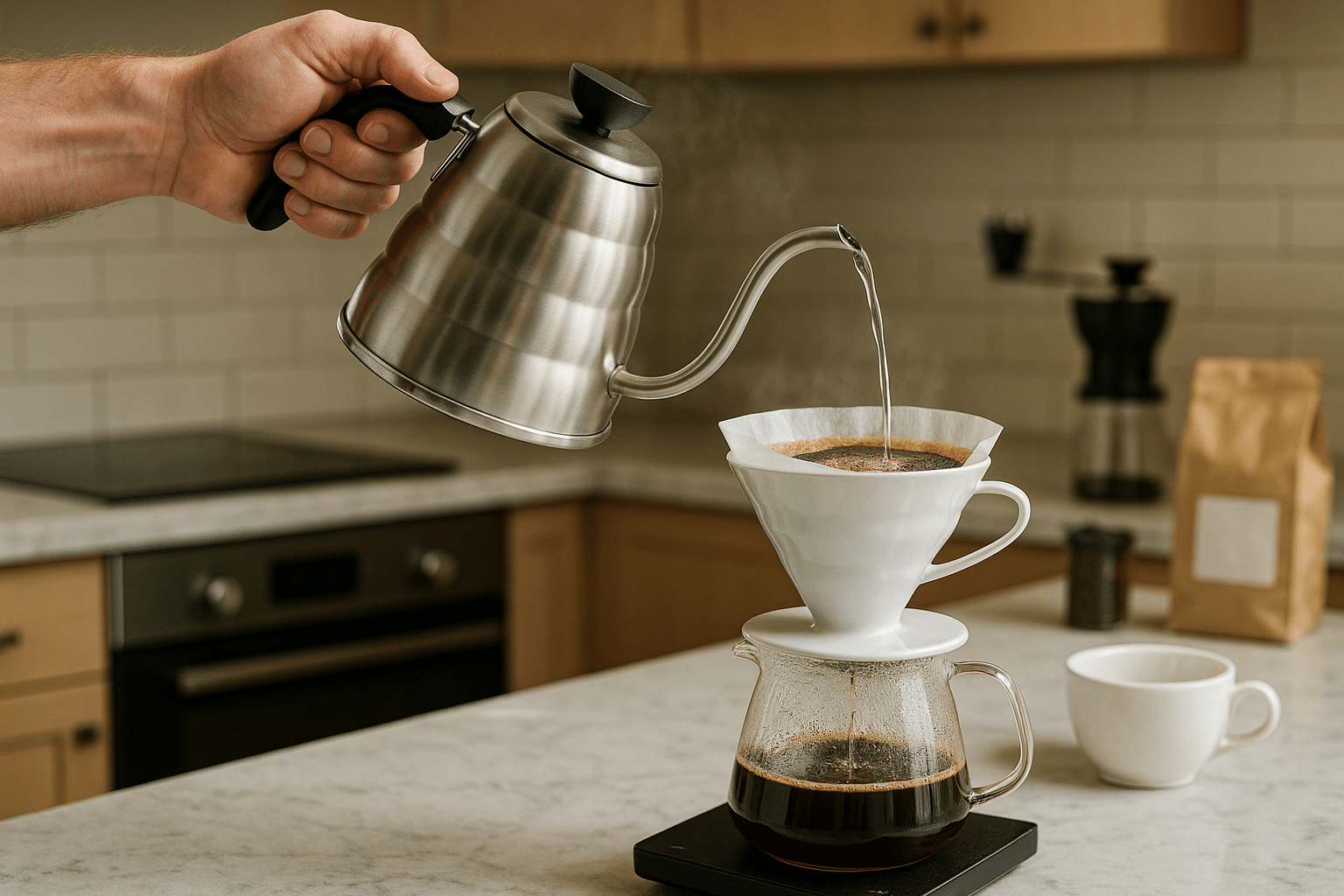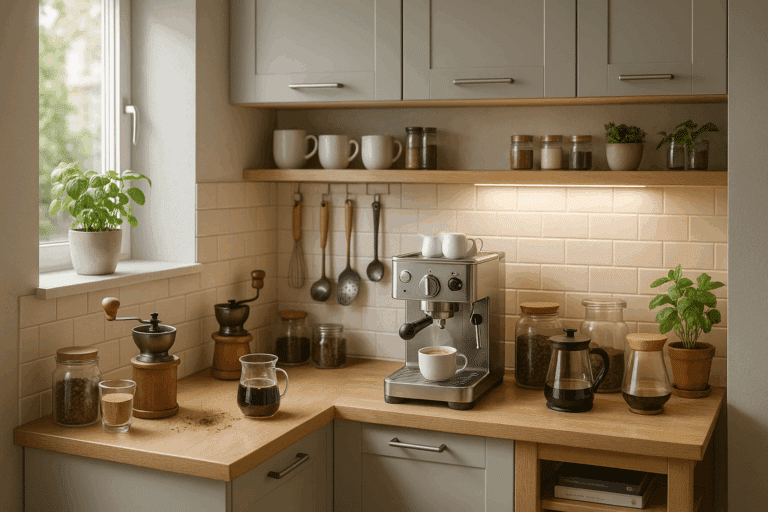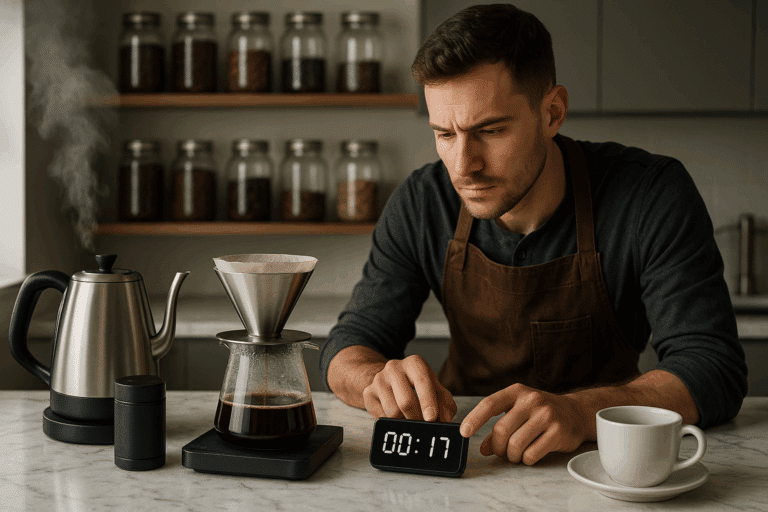Picture this: you’re nestled in a cozy café, the aroma of freshly ground coffee beans wafting through the air, the barista’s hands dancing rhythmically as they expertly brew a cup of pour-over coffee. You’re captivated by the meticulous attention to detail, the symphony of precision and control. And you wonder: could you recreate this magic at home? Yes, you can! With the right knowledge and tools, particularly the Hario V60, the art of making a perfect cup of pour-over coffee is no longer confined to artisan coffee shops. 😊
In this guide, we’ll unlock the secrets behind a great cup of pour-over coffee, diving deep into the science, the craft, and the satisfaction of mastering the art of brewing with the Hario V60. Get ready to elevate your coffee game to barista-level. 💪
The Journey Towards Coffee Perfection
Our odyssey will start by addressing the fundamentals: the principles and variables behind a great cup of coffee. The coffee world is an intricate cosmos that comprises several elements such as beans, water temperature, grind size, and brew method. To truly master the art of brewing, one must understand these factors and their interplay. It’s like writing a code, where each line contributes to the overall output. And our output? The perfect pour-over coffee. 🏆
The Role of the Hario V60 in Brewing
Next, we’ll set our spotlight on the star of our show: the Hario V60. How does this seemingly simple tool contribute to a well-crafted cup of coffee? We’ll discuss its design, how it compares to other brewing tools, and why it has become a favorite among coffee enthusiasts and professionals alike. It’s like choosing the right software architecture for a project: with the right tool, you can create something truly remarkable. 🛠️
Step-by-Step Guide to Using the Hario V60
Of course, a guide would not be complete without practical, step-by-step instructions. We’ll walk you through the whole process, from grinding your beans to the final pour. But remember, brewing is both a science and an art. Therefore, while we’ll give you a precise blueprint to follow, we’ll also encourage you to experiment and tweak the process until you find your perfect cup. Like debugging a program, sometimes it takes a few tries to get everything just right. 🎯
By the end of this guide, not only will you have a comprehensive understanding of the pour-over brewing process, but you will also gain a newfound appreciation for the complexity and beauty of coffee. Whether you’re a seasoned coffee connoisseur or a novice just stepping into the world of specialty coffee, this guide will serve as a practical and engaging resource in your coffee journey. ☕
So, are you ready to dive in? Great! Put your barista apron on, grab your Hario V60, and let’s master the art of brewing pour-over coffee together! 🎉
Understanding the Pour Over Coffee Technique
The pour over coffee technique is more than just a method for brewing coffee. It is a refined art that requires precision, patience, and a deep understanding of coffee grounds, water temperature, and brewing time. This technique offers a level of control that other brewing methods cannot match, giving you the power to extract the perfect balance of flavors from your coffee beans.
Among the pour over brewing devices available, the Hario V60 stands out due to its design, functionality, and the consistent quality of coffee it produces. Mastering the art of pour over coffee with the Hario V60 can seem daunting, but with a step-by-step guide and a bit of practice, you’ll soon be brewing coffee to perfection.
Before diving into the guide, it’s worth noting why the Hario V60 is so unique. The V60 is a cone-shaped brewing device with spiral ribs on the inner wall, which allow for maximum coffee expansion and water flow. It has a large single hole at the bottom, which controls the brewing time based on the grind size and pouring technique. To get a clear understanding of how the Hario V60 works, I recommend watching this video: “Hario V60 Coffee Brewing Tutorial” by the Specialty Coffee Association.
Hario V60: The Essential Components
Before we can begin brewing, we need to understand the essential components of the Hario V60 brewing process: the coffee beans, the grind size, the water, and the filter. Each of these components plays a crucial role in the outcome of your brew, affecting the flavor, aroma, and overall quality of your coffee.
Coffee Beans: The choice of coffee beans is up to your personal preference. However, for the best pour over experience, consider using freshly roasted beans. They provide a depth and richness of flavor that is often lost in pre-packaged or pre-ground coffee. The origin, roast level, and freshness of your beans will all contribute to the flavor profile of your coffee.
Grind Size: The size of your coffee grind directly impacts the extraction process. A fine grind will result in a longer extraction time, leading to a stronger and potentially over-extracted brew. Conversely, a coarse grind will speed up the extraction process, potentially leading to a weak or under-extracted coffee. For the Hario V60, a medium-fine grind is recommended.
Water: Water makes up more than 98% of your coffee, so its quality should not be overlooked. Always use clean, filtered water for brewing. The water temperature should be between 195 and 205 degrees Fahrenheit (90-96 degrees Celsius) for optimal extraction.
Filter: The Hario V60 uses specific cone-shaped filters. These filters not only fit the device perfectly but also contribute to the clarity of the brew by filtering out fine coffee particles.
To get a comprehensive view of how these components come together, check out the table below:
| Component | Description | Effect on Brew |
|---|---|---|
| Coffee Beans | Freshly roasted for optimal flavor | Flavor, aroma, overall coffee quality |
| Grind Size | Medium-fine for Hario V60 | Extraction time, brew strength |
| Water | Clean, filtered, and heated between 195-205°F (90-96°C) | Extraction efficiency, coffee flavor |
| Filter | Cone-shaped, specific to Hario V60 | Clarity of the brew |
The Step-by-Step Guide to Brewing with Hario V60
Now that we’ve covered the essentials, let’s dive into the step-by-step brewing process with the Hario V60.
Step 1: Heat your water to the correct temperature range (195-205°F or 90-96°C). While your water is heating, place the filter in the Hario V60, ensuring it’s perfectly fitted. Rinse the filter with hot water to remove any paper taste and pre-heat your brewing vessel. Discard the rinse water before brewing.
Step 2: Measure your coffee. A good starting point is a 1:15 coffee to water ratio. For example, for every 1 gram of coffee, you’ll need 15 grams (or milliliters) of water. Adjust this ratio according to your taste preference.
Step 3: Grind your coffee to a medium-fine consistency, similar to table salt. Pour the ground coffee into the filter, gently leveling it without compacting it. Place the V60 on a scale and tare it to zero.
Watch the video “How to Brew Coffee with the Hario V60” by Prima Coffee Equipment for a visual guide to these steps. Remember, practice makes perfect! So don’t worry if you don’t get it right on your first try. The art of brewing coffee is a journey of discovery, and each cup you brew is an opportunity to refine your technique and deepen your appreciation for this beloved beverage.
Understanding Extraction and Troubleshooting Your Brew
Understanding the concept of extraction is key to mastering the pour over method. Extraction refers to the process of pulling flavors from the coffee grounds using hot water. The goal is to achieve a balanced extraction, where the desirable flavors are maximized, and the undesirable ones are minimized.
If your coffee tastes too bitter, it may be over-extracted. This means that the water has pulled too many compounds out of the coffee, including the undesirable bitter ones. To remedy this, you can try using a coarser grind, lowering the water temperature, or pouring the water more quickly.
On the other hand, if your coffee tastes too sour, it is likely under-extracted. This means that not enough compounds have been extracted from the coffee. You can counteract this by using a finer grind, raising the water temperature, or pouring the water more slowly.
By adjusting these variables and tasting the results, you can perfect your brewing technique and achieve a balanced cup of coffee every time. To aid your journey, consider watching the video “How to Dial In Your Coffee Brew” by James Hoffmann, a world barista champion. His advice will give you a deeper understanding of coffee extraction and how to troubleshoot your brew.
Remember: brewing the perfect cup of coffee with the Hario V60 is an art that takes time and practice to master. But with patience, precision, and a willingness to experiment, you’ll be well on your way to brewing perfection.
Brewing Perfection: The Final Verdict
Mastering the art of pour over coffee with the Hario V60 is a rewarding endeavor that offers endless opportunities for experimentation and learning. Each step of the process—from selecting your beans and perfecting your grind size, to controlling your water temperature and pour technique—contributes to the final outcome. And with each brew, you’re not only crafting a delicious cup of coffee, you’re also honing your skills, refining your palate, and deepening your appreciation for the intricate art of coffee brewing.
Remember, the journey to brewing perfection is just as rewarding as the destination. So take your time, savor each step, and most importantly, enjoy the fruits of your labor. Happy brewing! ☕️

Conclusion
To wrap up, we’ve taken a deep dive into the world of software engineering, breaking down complex concepts into understandable bites. We’ve journeyed through the intricacies of coding, the importance of design principles, the significance of testing and debugging, and the crucial role of maintaining software applications. In essence, the field of software engineering is a challenging yet rewarding discipline that forms the backbone of our digital world.
The relevance of coding cannot be overstated. A significant portion of our day-to-day activities is powered by code, from our smartphones to our internet browsers. Understanding how to code is like learning a new language, enabling us to communicate with machines and create innovative solutions to real-world problems. As we’ve discussed, several languages, each with its unique strengths and use cases, can be used for coding. Some of these include Java, Python, C++, and many more.
Design principles, the blueprint for creating effective software applications, have also been a central focus. We’ve explored various principles like SOLID and DRY, which guide developers in creating applications that are scalable, maintainable, and efficient. Adhering to these principles results in software that is easier to manage, understand, and update.
Our examination of testing and debugging was another critical aspect of this exploration. It is essential to thoroughly test and debug software before its release to ensure it is bug-free and provides an exceptional user experience. Different types of testing methods were discussed, including unit testing, integration testing, and system testing, each designed to catch and fix bugs at different stages of the software development lifecycle.
Maintenance of software applications is as crucial as their development. Software maintenance ensures that applications remain effective and efficient as the technological landscape evolves. We’ve examined various forms of maintenance, including corrective, adaptive, perfective, and preventive maintenance.
In conclusion, software engineering is a vast and complex field, but hopefully, through this article, you’ve gained a clearer understanding of some of its critical aspects. So, whether you’re a seasoned developer, a beginner in the field, or just someone interested in how the digital world functions, this information is invaluable.
I encourage you to continue exploring this fascinating field. There’s always something new to learn, a new coding language to master, or a new software development methodology to discover. If you have any questions or thoughts, feel free to leave a comment below. 😊
Also, don’t forget to share this article with others who might find it helpful. After all, sharing knowledge is how we all grow. 🚀
Before I sign off, I would like to remind you that continued learning is the key to success in this field. You can check out resources like Codecademy, Coursera, and Udemy for further learning.
Thank you for staying with me until the end of this article. I hope you found it enlightening and enjoyable. Until next time, keep coding, keep creating, and keep innovating. 🌟
References:



